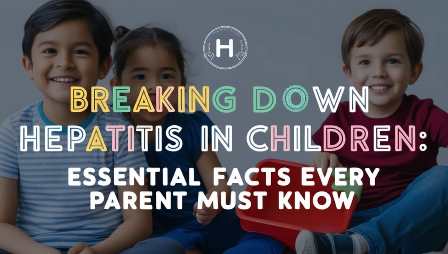Breaking Down Hepatitis in Children:
Essential Parenting KnowledgeViral infections cause hepatitis in children, which is inflammation of the liver. Most people have viral hepatitis types A, B, C, D, and E, although autoimmune illnesses, metabolic problems, toxins, and drugs may also cause it.
Child viral hepatitis types:
Hepatitis A: Spread by contaminated food or water, this virus is acute and seldom causes liver issues.
Hepatitis B can cause persistent liver disorders if it is passed from mother to child through blood, body fluids, or childbirth.
Hepatitis C: This virus spreads through the bloodstream and, if left untreated, can lead to liver damage.
Only hepatitis B carriers get hepatitis D. This may aggravate hepatitis B.
Hepatitis E: Mostly found in impoverished nations, it is spread by polluted water and causes acute hepatitis, which can be severe in pregnant women.
Pediatric hepatitis symptoms
Different types and stages of hepatitis might cause different symptoms in children.
These are common childhood hepatitis symptoms:
Jaundice:
Skin and eye yellowing.Abdominal discomfort: Stomach pain, particularly in the liver.Symptoms include nausea and vomiting.Unusual fatigue or weakness.
Dark urine:
Unusual urine color.The stool may be pale yellow. Appetite loss.
Fever:
Some kids have fever.
Joint pain:
Sometimes joints hurt.Not all children with hepatitis have these symptoms, and their severity may vary.
Some children with acute or chronic hepatitis have no symptoms, especially early on.
If your kid has hepatitis or other troubling symptoms, see a doctor for examination, diagnosis, and treatment.
Child hepatitis diagnosis:
We evaluate the type, severity, and causes of liver inflammation in children to diagnose hepatitis.
An outline of diagnosis:
1. The Medical History and Physical Exam:
A doctor will ask about symptoms, risks, family history, and a physical exam to check for liver inflammation indications, including jaundice, abdominal discomfort, or enlargement.
2. A Blood Test:
Liver function tests (LFTs) examine blood enzymes and proteins to assess liver function. Elevated levels may suggest liver injury.
Blood tests may detect antibodies or antigens from hepatitis viruses A, B, C, D, or E.
CBC: To detect infection or anemia.Liver problems may impair blood clotting; hence, coagulation investigations are done.
3. Image Studies:
Ultrasound imaging examines the liver for signs of inflammation or structural changes.Some patients may get an MRI or CT scan to better see the liver and surrounding organs.
4. If required, liver biopsy:
A microscope can examine a small sample of liver tissue. It determines liver damage, hepatitis type, and acute or chronicity.
5. Other exams:
The viral load test measures blood virus levels, notably for hepatitis B and C.Detects autoimmune hepatitis using antibodies.Serological testing is used to rule out liver infections and other potential causes.
6. Consider complications:
If there is a suspicion of persistent hepatitis, additional tests such as fibrosis or cirrhosis may be necessary to determine liver damage.
7. Monitoring and follow-up:
We may need follow-up sessions to check liver function and therapy efficacy.Correct diagnosis is crucial for pediatric hepatitis therapy and management.
Using this thorough approach, healthcare practitioners can focus child care by understanding the condition’s source and severity.
Child transmission pathwaysHepatitis in children may spread via many methods depending on the infection.
The primary transmission mechanisms for the most common types of hepatitis are as follows:
1. Hepatitis A:
Virus-contaminated feces contaminate food, drink, or items. Poor sanitation and hygiene may spread it. HAV may infect children via contaminated food or water.
2. HBV:
Hepatitis BDuring delivery, an infected woman might pass HBV to her kid.Sharing contaminated needles, inadvertent needle sticks, or contact with open sores or wounds may infect children.
3. Hepatitis C:
Blood contact: Similar to hepatitis B, transmission happens through blood contact. It may spread by sharing needles, blood transfusions (rare in modern nations owing to screening), or, rarely, from an infected mother to her child after birthing.
4. Hepatitis D:
Hepatitis B coinfection: HDV requires hepatitis B to spread. HBV is typically infected or acquired concurrently.
5. Hepatitis E:
Transmission typically occurs when people consume polluted water or food, especially in areas with poor sanitation and hygiene.
6. Alternate Methods:
Unprotected intercourse or personal contact with an infected individual may transmit hepatitis B and C.Vertical transmission: Hepatitis B and, less often, C may be transmitted from mother to child during pregnancy or birth.
Child Hepatitis
Child hepatitis prevention:
Childhood hepatitis prevention involves immunization, cleanliness, food and water safety, and avoiding exposure to infection sources.
Key preventative measures:
1. Vaccination:
Children’s immunization schedules typically include immunization against hepatitis A. Two dosages are given months apart.HBV vaccine: Given soon after birth, with further doses at intervals. This vaccination helps prevent mother-to-child hepatitis B transmission.
2. Proper Hygiene:
Hand washing: After using the restroom and before eating or cooking, encourage kids to wash their hands with soap and water.Avoid sharing personal items: Tell kids not to share toothbrushes, razors, or anything that might spread blood or body fluids.
3. Food and Water Safety:Safe drinking water:
Give kids clean water. In places with uncertain water quality, utilize bottled or purified water.Proper food handling: Teach kids to wash produce, prevent undercooked meat, and keep food at the right temperature.
4. Safe sexual behaviors are important for older children.To prevent STDs, particularly hepatitis B and C, teach youth about safe sex.
5. Avoiding contact
with blood or bodily fluidsInform kids about blood and body fluid hazards. Accidental exposure to these toxins requires cleaning and medical attention.
6. Mothers’ screening and prevention:
Test pregnant women for hepatitis B to avoid mother-to-child transmission. Promptly administer the vaccination and immune globulin to newborns of hepatitis B moms.
7. Travel Warnings:
Families visiting high-risk locations for hepatitis, particularly A or E, must take measures including immunization and food and water safety. Promoting a healthy lifestyle, immunization, and cleanliness from an early age may dramatically lower children’s hepatitis risk. Preventive health care requires frequent checks and vaccinations.
Pediatric hepatitis treatmentPediatric hepatitis treatment varies based on kind, severity, and acute or chronicity.
Here are general methods:
1. Supportive Care:Supportive treatment may suffice for severe instances. To recuperate, the body needs rest, fluids, and a nutritious diet.
2. Drugs that fight virusesAntiviral medicines may treat chronic hepatitis B and C. These medications prevent viral multiplication, decreasing liver damage and consequences. Drug selection and duration depend on several variables and require side effects and efficacy monitoring.
3. Liver Transplant:For severe liver damage or failure from chronic hepatitis or cirrhosis, liver transplants may be necessary. When other therapies fail or the liver damage is extensive, we consider liver transplants.
4. Treatment of Complications:Ascites, variceal hemorrhage, and hepatic encephalopathy may necessitate special therapy.
5. Monitoring and Following:To evaluate therapy and identify the development of liver disease, blood tests and imaging examinations are necessary.
6. Preventive measures:Immunizing against hepatitis A and B reduces the risk of chronic liver disease. Unvaccinated children need immunizations.
7. Changes in lifestyleManage hepatitis by encouraging a healthy lifestyle, including a balanced diet, frequent exercise, and avoiding alcohol and liver-stressing drugs.
8. Adjusting medication:The doctor may adjust or change other liver-damaging drugs to lessen liver strain in children.
9. Education, Support:Educating and supporting the kid and family about the diagnosis, medication adherence, and frequent follow-ups is essential for hepatitis management.Individual conditions and hepatitis infection features determine treatment strategies.
Consulting a pediatric hepatologist enables accurate assessment and individualized therapy for hepatitis in children.
Hepatitis in Children FAQs
1. What is pediatric hepatitis?
Hepatitis in kids is liver inflammation. Viruses, poisons, or healthcare issues may cause it.
2. What are common childhood hepatitis symptoms?
Jaundice, stomach discomfort, nausea, vomiting, lethargy, and dark urine are symptoms.
3. How do children develop hepatitis?
Viral hepatitis A, B, C, D, or E may be transmitted to children by contaminated food, drink, blood, or an infected mother during delivery.
4. Is childhood hepatitis preventable?
Yes! Vaccinations against Hepatitis A and B, maintaining cleanliness, and adopting safe food and drink habits can reduce the risk.
5. Kids’ hepatitis diagnosis:
how?We use blood tests, liver function tests, ultrasounds, and liver biopsies to diagnose hepatitis in children.
6. What pediatric hepatitis therapies exist?
Treatment depends on hepatitis’s type and severity. It may include antivirals, supportive treatment, or a liver transplant.
7. Are there long-term consequences of hepatitis in children?
Untreated hepatitis may cause liver damage, cirrhosis, or failure.
8. Can hepatitis-afflicted kids attend school or daycare?
The child’s symptoms and type of hepatitis determine the outcome. Children are welcome to attend, but they should consult a doctor first.
9. Is childhood hepatitis contagious?
Indeed, hepatitis A and B are communicable. Maintaining proper hygiene helps stop its spread.
10. Can hepatitis-afflicted kids do sports?
Typically, unless a doctor instructs otherwise, They must not be overtired or uncomfortable.
11. Do children with hepatitis have special diets?
A balanced diet matters. Some propose avoiding fatty or fried meals to reduce liver strain.
12. Is childhood hepatitis curable?
Acute hepatitis A may resolve without therapy. Some, like chronic hepatitis B or C, need continuing treatment.
13. Is childhood hepatitis common?
Geographic location, immunization rates, and cleanliness affect the prevalence of hepatitis in children.
14. Does hepatitis recovery risk reinfection?
In some circumstances. Failure to prevent exposure could lead to the development of hepatitis B reinfection.
15. How many checkups are necessary for children with hepatitis?
Regular checkups are necessary for liver health. Child’s condition and doctor’s advice determine frequency.
These answers provide basic information on juvenile hepatitis, but healthcare specialists should provide individualized advice.
Early identification, management, and prevention of complications require knowledge about the types, symptoms, preventative measures, and therapies of hepatitis in children. Vaccination, cleanliness, and regular medical checkups protect youngsters against hepatitis.

